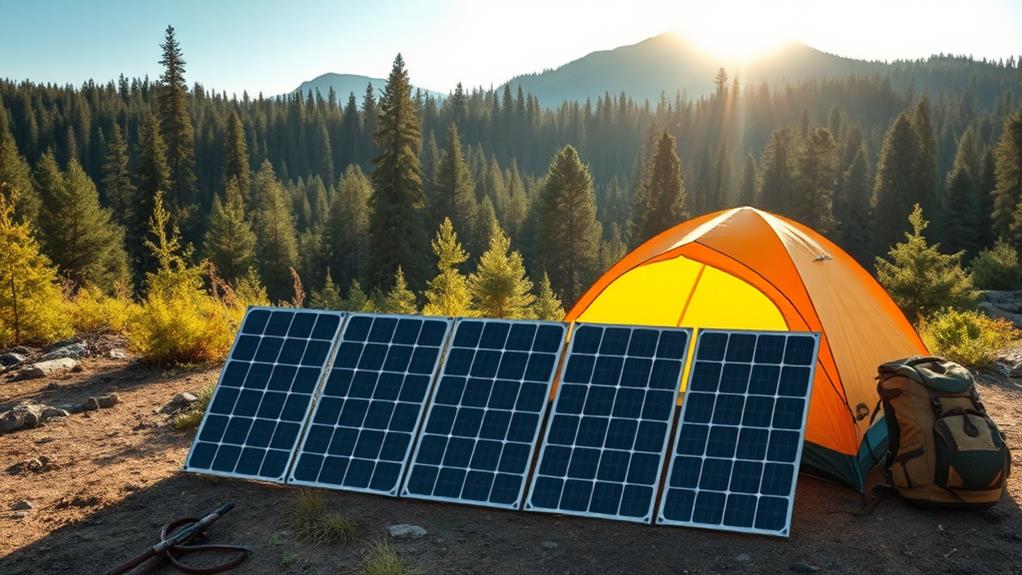Solar power banks offer eco-friendly charging solutions for your devices on the go. Top models in 2025 feature high capacities ranging from 10,000mAh to 49,800mAh, with fast charging capabilities up to 20W. Many are equipped with multiple outputs, integrated cables, and wireless charging options. Durability is key, with IP65 waterproof ratings and rugged designs suitable for outdoor use. Advanced safety features protect against overcharging and short circuits. Battery types include efficient lithium-polymer cells, providing up to 1800 charging cycles. When selecting a solar power bank, consider factors such as capacity, charging speed, portability, and additional features like built-in flashlights. Further exploration will reveal the nuances of each model’s specifications and performance.
Key Takeaways
- Solar power banks offer eco-friendly charging for outdoor enthusiasts with capacities ranging from 10,000mAh to 49,800mAh.
- Top models feature fast charging, multiple outputs, and durability with high IP ratings for water and dust resistance.
- Many solar power banks include additional features like built-in flashlights, compasses, and wireless charging capabilities.
- The best solar power banks balance high capacity with portability, offering multiple device charges while remaining relatively compact.
- Solar charging efficiency varies based on sunlight conditions, with USB charging typically being faster and more reliable.





![[Upgraded] FlexSolar 15W Small Solar Panel Charger 5V USB Output ETFE Lightweight Foldable Portable Powerfilm Energy IP67 Waterproof Emergency Camping Hiking Backpacking for Cell Phones Fans](https://m.media-amazon.com/images/I/714738Whe8L._SS520_.jpg)

BLAVOR Solar Charger Power Bank with Wireless Charging (10,000mAh)
- Brand-Oriented and Outdoor Charger Pro: With over 10 years of experience in solar power banks, BLAVOR has already gained the favor and trust of...
- Leading USB C Input Output Tech and Qi Wireless: The latest upgrade includes a USB-C output with 20W fast charging capability, which can charge your...
- Premium Battery and Smallest Solar Charger: BLAVOR uses the safer Lithium-cobalt battery, which is 50% more cycling times than a normal Li-polymer...
Last update on 2025-11-17 / Affiliate links / Images from Amazon Product Advertising API
Outdoor enthusiasts and adventure seekers, take note: the BLAVOR Solar Charger Power Bank is your go-to companion for off-grid power. This 10,000mAh powerhouse boasts 20W fast charging capabilities, compatible with a wide range of smart devices. You’ll appreciate its ability to charge three devices simultaneously, utilizing USB-C and wireless charging technologies. The lithium-cobalt battery offers 50% more cycling times than Li-polymer alternatives, ensuring longevity and reliability.
Designed for rugged use, the BLAVOR features an IPX5 waterproof rating and a durable outer case made of flame-retardant ABS and PC materials. Its compact dimensions (5.9 x 3.1 x 0.8 inches) and lightweight construction (9.3 ounces) make it highly portable. You’ll find additional outdoor-friendly features, such as dual super bright flashlights and an included compass carabiner. With a 4.3-star rating from over 42,000 customers, this solar charger ranks #2 in Cell Phone Solar Chargers, solidifying its position as a top choice for 2025.
Best For: Outdoor enthusiasts, campers, and travelers who need a reliable, rugged, and versatile power source for their devices while away from traditional power outlets.
Pros:
- 20W fast charging capability with simultaneous charging of up to 3 devices
- Durable design with IPX5 waterproofing and flame-retardant materials
- Additional features like dual flashlights and compass carabiner enhance its outdoor utility
Cons:
- Solar charging may be slow and primarily serves as a backup option
- 10,000mAh capacity might not be sufficient for extended trips or multiple device charges
- Relatively heavy at 9.3 ounces compared to non-solar power banks of similar capacity
Solar Charger Power Bank, 42800mAh Wireless Portable Charger
No products found.
For those seeking a versatile and long-lasting power solution, the Solar Charger Power Bank from Sudrov stands out with its impressive 42800mAh capacity. This wireless portable charger boasts QC3.0 fast charging at 15W and features six outputs, including a Qi-compatible wireless charging pad. With three built-in cables (Type-C, Lightning, and Micro USB) and an additional USB-A port, you can simultaneously charge up to six devices.
The power bank’s high-density Li-polymer battery, protected by a smart IC chip, offers over 1800 charging cycles. Its rugged design incorporates waterproof, shockproof, and dustproof elements, making it suitable for outdoor use. Additional features include dual LED flashlights with three modes (SOS/Strobe/Stable), a thermometer, and a red indicator light for emergencies. With a 4.5-star rating from 253 customers, this Sudrov model (PN-W33A) ranks #138 in Cell Phone Portable Power Banks on Amazon.
Best For: This Solar Charger Power Bank is best for frequent travelers, outdoor enthusiasts, and those who need to power multiple devices simultaneously for extended periods without access to wall outlets.
Pros:
- High capacity 42800mAh battery with multiple charging options, including wireless and fast charging
- Durable design with waterproof, shockproof, and dustproof features for outdoor use
- Versatile functionality with built-in cables, LED flashlight, and emergency features
Cons:
- May be bulky and heavy due to its large capacity, potentially inconvenient for everyday carry
- Solar charging capability not explicitly mentioned, despite being called a “Solar Charger”
- Higher price point compared to standard power banks with similar capacity
Hiluckey Solar Charger 25000mAh Power Bank with 4 Solar Panels
No products found.
Adventure seekers and off-grid enthusiasts will find the Hiluckey Solar Charger 25000mAh Power Bank an essential companion. This robust device boasts a 25000mAh capacity, capable of charging smartphones 6-8 times and tablets 2.5 times. With 4 solar panels generating up to 6W in direct sunlight, it offers eco-friendly charging options. The power bank features 3 USB outputs, including a USB-C port for input/output and dual USB-A ports, enabling simultaneous charging of multiple devices. Its 15W fast-charging capability can boost an iPhone to 50% in just 30 minutes. While solar charging efficiency varies, the unit excels in emergency situations and outdoor activities. Users should note its substantial size and weight, which are offset by its high capacity and durability, including water resistance and a secure snap closure.
Best For: Outdoor enthusiasts, campers, hikers, and emergency preparedness-minded individuals who need a reliable power source in off-grid situations.
Pros:
- High capacity 25000mAh battery can charge multiple devices several times
- Versatile charging options with solar panels and USB-C/USB-A ports
- Durable design with water resistance for outdoor use
Cons:
- Solar charging can be slow and inconsistent, especially in suboptimal conditions
- Bulky and heavy, which may be inconvenient for some users
- Some users reported issues with product reliability and customer service
GOODaaa Power Bank Wireless Charger with Built-in Hand Crank and Solar Charging
No products found.
If you’re looking for a power bank that’s ready for anything, the GOODaaa Power Bank Wireless Charger with Built-in Hand Crank and Solar Charging is a top contender. This 45800mAh capacity device combines solar charging with a hand crank generator, offering versatile power solutions for emergencies. It supports up to 7 devices simultaneously through 3 built-in cables (iOS, USB-C, Micro USB), 3 output ports (2 USB, 1 USB-C), and a wireless charging area. With 5 input methods and smart protect IC, it guarantees efficient and safe charging. The power bank excels in outdoor activities, featuring dual LED flashlights with multiple modes and a built-in compass. Its waterproof, shockproof, and dust-proof design withstands harsh environments. While solar charging efficiency may vary, users report multiple device charges on a single full charge, making it a reliable choice for extended use.
Best For: Outdoor enthusiasts, emergency preppers, and frequent travelers who need a versatile, high-capacity power source with multiple charging options.
Pros:
- High capacity (45800mAh) with support for up to 7 devices simultaneously
- Multiple charging methods including solar, hand crank, and traditional power input
- Durable design with waterproof, shockproof, and dust-proof features
Cons:
- Large size and weight may reduce portability
- Solar charging efficiency can be inconsistent, especially in cloudy conditions
- Some users report issues with battery drainage when not in use
WONGKUO Solar Charger Power Bank 49800mAh with Built-in Cables
No products found.
Outdoor enthusiasts and tech-savvy travelers will appreciate the WONGKUO Solar Charger Power Bank‘s versatility and power. This 49800mAh Li-polymer battery powerhouse boasts an IP65 waterproof rating, ensuring durability in challenging conditions. With QC 3.0 fast charging technology and wireless charging capabilities, it’s compatible with a wide range of devices. The power bank features three output ports (USB-A, Type-C, Micro-USB) and four built-in cables, allowing simultaneous charging of up to five devices.
You’ll find the WONGKUO’s design practical and robust, constructed from high-strength ABS and PC materials. It’s not just a power bank; it’s a multi-functional device with a built-in flashlight, ideal for outdoor adventures. The solar panel provides an eco-friendly charging option, complementing the traditional adapter charging method. With an average rating of 4.4/5 stars from 257 customers, it’s ranked #114 in Cell Phone Portable Power Banks, highlighting its popularity among users seeking reliable, versatile charging solutions.
Best For: Outdoor enthusiasts, frequent travelers, and tech-savvy individuals who need a versatile, high-capacity power bank with multiple charging options and rugged durability.
Pros:
- High capacity 49800mAh battery with multiple charging ports and built-in cables
- IP65 waterproof rating and durable construction for outdoor use
- Versatile charging options including solar, fast charging, and wireless compatibility
Cons:
- Large capacity may result in a bulky and heavy design
- Solar charging may be slow and dependent on optimal weather conditions
- Higher price point compared to standard power banks without advanced features
Solar-Charger Power Bank 49800mAh Portable Solar Phone Charger
- Portable Charger, Power Bank , Dual USB Output and USB-C Input External Cell Phone Battery Pack for iPhone Samsung Galaxy, etc
- Portable-Charger-Power-Bank - 49800mAh Dual USB Power Bank Output 5V3.1A Fast Charger Portable Charger Compatible with Smartphones and All USB Devices
- Battery capacity: 49800.0 milliamp_hours
Last update on 2025-11-18 / Affiliate links / Images from Amazon Product Advertising API
For those seeking a rugged and versatile power bank, the Solar-Charger Power Bank 49800mAh stands out as a top contender. This UL, CE, FCC, RoHS, and UN38.3 certified device boasts a high-capacity 49,800mAh lithium polymer battery, equipped with extensive safety features including temperature, over-voltage, over-current, and short-circuit protection. You’ll appreciate its 15W fast charging capability, compatibility with a wide range of devices, and multiple outputs, including USB-C and USB-A&B, allowing simultaneous charging of up to three devices. The power bank’s outdoor utility is enhanced by its waterproof and dustproof design, integrated LED flashlight with three modes, and included carabiner for easy attachment. While solar charging serves as an emergency backup, the primary charging method remains USB, ensuring reliable power for your extended outdoor adventures.
Best For: Outdoor enthusiasts, frequent travelers, and those who need a high-capacity, durable power bank with emergency solar charging capabilities.
Pros:
- High capacity 49,800mAh battery with fast charging and multiple outputs
- Rugged, waterproof design with built-in LED flashlight and carabiner
- Extensive safety features and certifications for peace of mind
Cons:
- Solar charging is slow and meant only for emergencies
- Relatively heavy at 1.06 pounds, which may be cumbersome for ultralight hikers
- Large capacity means longer charging times when fully depleted
WONGKUO Solar Charger Power Bank 36800mAh (Waterproof, QC3.0 Fast Charging)
- Solar Charger Power Bank, 38800mAh Portable Phone Charger with 1 Type-C & 2 USB-A Ports
- ✅【DUAL USB OUTPUTS】This solar cell phone charger has a dual USB output port, which it makes easy to charge two smartphones simultaneously or any...
- ✅【36,800mAh LARGE BATTERY CAPACITY】Our solar phone charger has a 36800mAh high-density lithium polymer battery. The battery has a long life and...
Last update on 2025-11-18 / Affiliate links / Images from Amazon Product Advertising API
Adventure enthusiasts and power-hungry travelers will find their match in the WONGKUO Solar Charger Power Bank. This robust 36,800mAh powerhouse boasts QC3.0 fast charging capabilities, with an upgraded 5V/3.1A output port that’s 50% faster than its predecessor. The dual USB outputs allow simultaneous charging of two devices, while the versatile charging options include both outlet and solar panel modes. Constructed with high-strength ABS and PC materials, the power bank is IP65 waterproof, heat-resistant, shockproof, and dustproof, making it ideal for rugged outdoor use.
The WONGKUO Solar Charger features multiple intelligent security protection systems, including safeguards against overcharge, over-current, over-voltage, overload, and short circuits. Its built-in UL-tested batteries enhance safety during operation. Additional features include a built-in LED flashlight with three modes (Steady, SOS, and Strobe), a compass for navigation, and multiple USB ports, including a USB-C port for versatile device charging.
Best For: Outdoor enthusiasts, travelers, and emergency preparedness advocates seeking a durable, high-capacity power bank with solar charging capabilities.
Pros:
- Large 36,800mAh capacity with fast charging capabilities
- Rugged, waterproof design suitable for outdoor use
- Multiple safety features and additional functionalities like LED flashlight and compass
Cons:
- Solar charging may be slow or ineffective in certain conditions
- Relatively heavy due to high capacity
- May be overkill for users who don’t require such a large capacity
Factors to Consider When Choosing a Solar Power Bank

When selecting a solar power bank, you’ll need to evaluate several critical factors to guarantee you’re getting a device that meets your specific needs. These factors include the battery’s capacity and efficiency, charging speed and available methods, durability and resistance to environmental conditions, portability and weight considerations, and any additional features or functionality that might enhance the power bank’s utility. By carefully considering these aspects, you’ll be better equipped to choose a solar power bank that offers ideal performance, reliability, and value for your intended use case.
Battery Capacity and Efficiency
Battery capacity and efficiency stand out as vital factors when you’re sizing up solar power banks. The capacity, measured in mAh, determines how many times you’ll be able to charge your devices before the power bank itself needs replenishing. High-capacity models, ranging from 10,000mAh to 49,800mAh, offer multiple charges for smartphones and tablets. However, it’s important to take into account the charging efficiency alongside raw capacity. Lithium-polymer batteries often outperform traditional lithium-ion cells in energy density and longevity, potentially providing more usable power over time.
When evaluating efficiency, examine the power bank’s output specifications. Models featuring 15W or 20W fast charging capabilities can greatly reduce charging times. The charging method also impacts speed, with USB typically outpacing solar charging. For solar efficiency, panel size matters; 6W or larger panels capture more energy in direct sunlight. Additionally, battery longevity is a key factor. High-quality power banks may offer over 1800 charging cycles before noticeable capacity degradation, ensuring long-term reliability. By carefully weighing these factors, you’ll be better equipped to select a solar power bank that meets your specific needs for capacity, efficiency, and durability.
Charging Speed and Methods
As you explore the world of solar power banks, charging speed and methods emerge as critical factors in your decision-making process. High-performance models now offer fast charging capabilities of up to 20W, enabling devices like the iPhone 15 to reach 65% charge in just 30 minutes. However, it’s crucial to understand that charging speeds can vary greatly between different power banks and methods.
Most solar power banks incorporate multiple charging options, typically including USB and solar. While USB charging is generally faster and more reliable, solar charging efficiency depends on sunlight intensity and panel size. You’ll need to evaluate the trade-offs between these methods, as solar charging is often slower but provides off-grid versatility. The power bank’s capacity also influences charging efficiency; larger capacities of 42,800mAh or 49,800mAh offer multiple charges for smartphones and tablets but may require longer recharge times. For multitasking capabilities, look for models with multiple output ports, some supporting simultaneous charging of up to 6 devices. Finally, prioritize safety features such as overcharge protection, overcurrent protection, and temperature control to safeguard your devices during charging, particularly when utilizing solar methods.
Durability and Weather Resistance
Outdoor enthusiasts and adventure seekers know that a solar power bank‘s durability and weather resistance can make or break its usefulness in challenging environments. When analyzing options, prioritize models with robust IP ratings, such as IP65 or IPX5, which indicate superior protection against water and dust ingress. These ratings guarantee the device’s reliability in diverse outdoor conditions, safeguarding its internal components from environmental hazards.
Look for power banks constructed with high-strength materials like ABS (Acrylonitrile Butadiene Styrene) and PC (Polycarbonate), which offer shockproof and heat-resistant properties. These materials enhance the device’s ability to withstand accidental drops, impacts, and extreme temperatures often encountered during outdoor activities. Additionally, consider models featuring built-in flashlights and compasses, as these tools can prove invaluable for navigation and emergency situations. To maximize portability, opt for lightweight designs with integrated carabiner clips, allowing for easy attachment to backpacks or gear. When evaluating durability claims, scrutinize customer feedback regarding real-world performance in various weather conditions, as some products may exhibit inconsistent solar charging efficiency under direct sunlight, impacting their overall reliability in outdoor settings.
Portability and Weight
Portability and weight stand as key considerations when selecting a solar power bank for your outdoor adventures. When evaluating options, you’ll find that weights can vary considerably, ranging from lightweight models at 9.3 ounces to heftier units exceeding 1 pound for higher capacities like 49,800mAh. It’s essential to strike a balance between capacity and weight, especially if you’re planning extended hiking or camping trips where every ounce matters. Compact dimensions, typically around 5.9 x 3.1 x 0.8 inches for smaller power banks, contribute to enhanced portability, allowing for easier transportation during outdoor activities.
Consider the form factor of the power bank, as thickness and overall size impact how easily it fits into pockets or bags without consuming excessive space. Some models come equipped with carabiner clips, facilitating attachment to backpacks and improving portability during travel. When selecting a solar power bank, prioritize designs that optimize the weight-to-capacity ratio while maintaining a slim profile. This approach guarantees you’ll have a power source that’s both capable and convenient to carry, maximizing its utility during your outdoor excursions without becoming a burden.
Additional Features and Functionality
When selecting a solar power bank, five key features can greatly enhance its functionality and versatility. First, prioritize models with multiple output ports and integrated cables, allowing for simultaneous charging of several devices—a vital feature for outdoor enthusiasts. Second, consider power banks equipped with supplementary tools like built-in flashlights, compasses, or emergency indicators, which can prove invaluable during outdoor excursions or emergency situations. Third, opt for units boasting rugged, weatherproof designs (e.g., IP67 or IP68 rated) to guarantee durability in harsh environments. Fourth, look for fast charging capabilities, such as QC 3.0 or 15W output, which can considerably reduce device charging times by up to 80% compared to standard 5W charging. Finally, verify that the solar power bank incorporates a reliable internal security system to safeguard against overcharging, overcurrent, and short circuits. This advanced circuitry typically includes features like smart IC chips and multiple protection mechanisms, assuring safer usage and prolonged battery life. By prioritizing these additional features and functionalities, you’ll maximize the utility and reliability of your solar power bank in various scenarios.
Frequently Asked Questions
How Long Does It Take to Fully Charge a Solar Power Bank?
The charging time for a solar power bank varies considerably based on several factors. You’ll find that capacity, solar panel efficiency, and sunlight intensity all play vital roles. Typically, you can expect a full charge to take anywhere from 25 to 50 hours with solar power alone. However, if you’re using a wall outlet, it’ll be much faster, usually between 4 to 8 hours. It’s essential to mention that many solar power banks also offer USB charging for quicker replenishment.
Can Solar Power Banks Charge Devices During Cloudy Weather?
You can charge devices using solar power banks during cloudy weather, but their efficiency is considerably reduced. Solar panels rely on photovoltaic cells, which convert light into electricity. In cloudy conditions, these cells receive less direct sunlight, resulting in slower charging rates. However, most solar power banks incorporate built-in batteries, allowing you to pre-charge them via USB or wall outlets. This dual-charging capability guarantees you’ll have power available even when solar charging is suboptimal due to weather conditions.
Are Solar Power Banks Safe to Use on Airplanes?
You’ll find that most solar power banks are safe to use on airplanes, as they comply with Federal Aviation Administration (FAA) regulations. These devices typically contain lithium-ion batteries with capacities below 100 watt-hours, which are permitted in carry-on and checked baggage. However, you should always check your specific airline’s policies, as some may have additional restrictions. Remember to disconnect any connected devices and store the power bank in your carry-on luggage for easy access during security screening.
What’s the Average Lifespan of a Solar Power Bank?
The average lifespan of a solar power bank typically ranges from 3 to 5 years, depending on usage patterns and maintenance. You’ll find that factors such as charge cycles, environmental conditions, and battery chemistry greatly impact longevity. Li-ion cells, commonly used in these devices, can withstand 300-500 full charge cycles before capacity degradation becomes noticeable. To maximize lifespan, you should avoid extreme temperatures, maintain partial charges, and use high-quality charging equipment. Regular firmware updates can also optimize performance and extend your power bank’s useful life.
How Do Solar Power Banks Compare to Traditional Power Banks in Efficiency?
Like a tortoise and hare in the energy race, solar power banks and traditional power banks differ in efficiency. You’ll find that solar power banks generally have lower charging efficiency, typically around 20-25%, compared to traditional power banks’ 80-90% efficiency. However, solar banks offer the advantage of renewable energy generation, albeit at a slower rate. They’re ideal for outdoor use, where access to electrical outlets is limited. Traditional power banks, conversely, provide faster, more reliable charging but require pre-charging from the grid.












